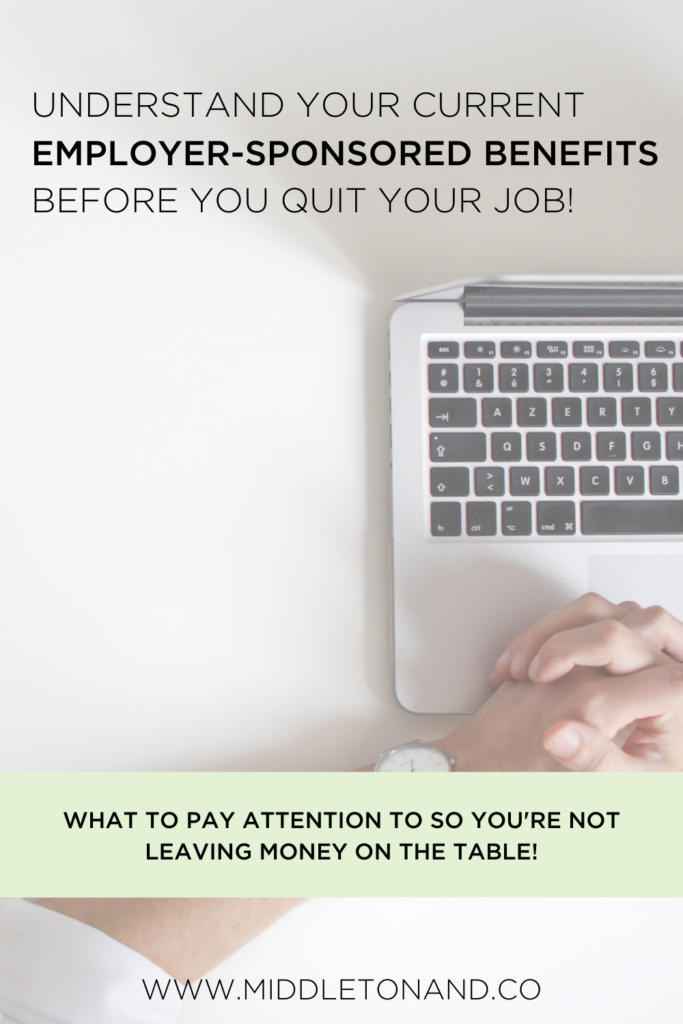When accepting a job, we focus on total compensation, not just the salary they offer. Well, the same is true when we’re thinking about leaving a company too.
We often hear people say they’re staying in a job they don’t like anymore (and sometimes completely hate!) just because of the benefits.
Benefits can play a big role, yes, but please don’t let them be the reason you don’t take the sabbatical you’ve been dreaming of. Let’s understand what you have so you can be savvy about (and prepared for) leaving some of those benefits behind!
So what benefits will go away once you give your notice, and which ones can you take with you?

Employer Retirement Savings Plans: are you leaving money on the table?
Pay attention to your employer savings plan handbook (often called a Summary Plan Description) – there’s some good stuff in there!
It will give you a lot of information that you’ll want to know when you are considering moving on to the next thing…and you can refer back to it without bringing any attention to your plans of departure by asking your manager or HR.
So first thing’s first, know what you have now. Which type of plan(s) are you currently participating in?
- Defined benefit plan: This plan type typically provides a fixed monthly benefit in retirement. They are generally 401(a) and/or pension plans, and you may or may not be able to roll these benefits into another retirement savings plan once you leave your employer. We see fewer of these plans these days, but they can still be found in fields like education, medical, or trades.
- Defined contribution plan: This is the most common plan type we see these days. Examples include 401(k)s, SIMPLE IRAs, 403(b) tax-sheltered annuities, profit-sharing plans, money purchase plans, and SEP IRAs. As long as the account has a minimum of $5,000 in it when you leave your job, you can typically choose to keep the account where it is, roll it into another active employer-sponsored retirement plan if/when you start a new job, or roll it into a Rollover IRA. Note that you may have a combination of pre-tax, Roth, and/or after-tax contributions, which should always be kept separate.
- Deferred compensation plan: A deferred compensation plan (or 457 plan) withholds a portion of an employee’s current compensation until a future date. These plans can typically be left where they are, or rolled into another employer retirement plan or IRA once you are no longer participating in the plan. Deferred compensation plans are pre-tax savings, so you want to make sure to keep that tax status if you decide to roll it out of the plan.
- Employer-sponsored stock plans: These are tax-advantaged ways to allow employees to participate in the growth of the company via stock ownership. This can be done in a variety of ways, but the most common plan types include Employee Stock Ownership Plans (ESOP), Employee Stock Purchase Plans (ESPP), Restricted Stock Units (RSUs), and stock options. These are generally after-tax savings plans, and the sale of the stock typically has a tax implication in the year of sale.
It’s important to note that each of the above plan types has different tax consequences (either immediate or in the future), and potential forfeitures and/or penalties that you want to be aware of before you jump ship.
Does your employer savings plan have a vesting schedule?
What is vesting? It’s a retirement plan feature where participants get to keep a certain percentage of the employer contribution after a certain number of years of employment. Employee contributions to the plan, however, are always immediately 100% vested.
There are a variety of ways that an employer can set up their retirement plan depending on what type of incentives it wants to give its employees. For example, a 6-year vesting schedule gives you gradual ownership of the employer contributions (0% in year 1, 20% each year from years 2-6). A 3-year vesting schedule might look like 0% in years 1 and 2, but 100% in year 3.
If you are not 100% vested in the plan when you leave the company, it’s important to know that you will only keep the vested percentage of the account.
What other timing issues should you be aware of when you are thinking about quitting your job?
Retirement plans are not the only plans that are subject to time restrictions. Restricted Stock Units (RSUs), for example, are also subject to a vesting schedule. You keep the vested shares at the time of your departure because you own them outright, but you may forfeit any unvested shares once you leave the company.
Stock options are also subject to time limits. Stock options typically expire within 90 days of leaving the company, so you could lose them if you don’t exercise them before or shortly after you quit your job.
And if you’ve received company stock compensation, and the company is privately-held, the share price may be valued at certain times in the year. In that case, the date of valuation is an important date to be aware of, as it impacts the total value of the shares you own. Additionally, dividends on the privately-held stock, if applicable, may be calculated or distributed on certain dates. It may make sense to plan your termination date around the dividend payment schedule.
How (and when) does your company make its employer contribution?
A company can decide if, and how, it wants to make contributions to the employer savings plan for its employees.
The most common types of employer contributions are either matching up to a specified percentage (say 100% match up to 3%, or 100% match up to the first 2% and then 50% on the next 6%) of the amount the employee contributes, or a flat contribution (say, for example, 15% of your annual salary whether or not you make an employee contribution).
Knowing how and when the employer makes contributions may help you decide if there is a better time of year to give your notice.
Considerations:
- When in the year do you get the employer contribution? You may want to wait to give notice until after you have received the employer contribution for the prior year
- What compensation are the employer contributions based on? If the employer contribution percentage includes any bonuses or commissions, you may want to consider when performance reviews (and bonuses, raises, promotions, etc.) are conducted during the year
- If your employer contribution is a matching contribution, you may choose to time your departure in line with a calendar year, when annual contribution limits are reset
- If it’s a flat contribution when in the year is the contribution made? Is it monthly, quarterly, or annually? This may help you decide whether you want to stick around for a bit or cut your losses

Insurance and Other Benefits
Health, Vision, Dental Benefits
Leading up to your planned departure, there are a few questions to ask yourself regarding your insurance benefits:
- Are you on company health insurance? If so, what is the policy for when you leave your job? Do you want to time your departure on a certain day of the month to bridge any waiting period you may be subject to on your new health insurance plan?
- What is the change in your share of premium cost? How will this affect your monthly cash flow?
- Is the new coverage better or worse – do you need to bulk up your savings to account for potential higher out-of-pocket costs?
- Is there an FSA account you should draw down before you leave?
- Should you plan to get all your medical, dental, and vision appointments squared away before your coverage ends?
- Does COBRA make sense for a period of time? What is the additional cost you should plan for?
What’s your company’s policy on Sick Days and Paid Time Off (PTO)
If the policy is use-it-or-lose-it, does it make sense to draw down your PTO before giving your official notice? Or does that money get paid out to you in your final paycheck? Take a few minutes to look at the specifics – is there a maximum amount that can be paid out? If PTO has rolled over from a prior year, is it eligible to be paid out?
How can you coordinate your exit to make sure you get the full advantage of the benefits you’ve already earned?
Life insurance and disability insurance
Who is currently paying the premium?
Is the coverage portable, or does it end with your termination of employment?
Do you need to account for an additional line item in your personal budget to pay for continued insurance after you leave your company?
Do you need to consider purchasing individual coverage before you lose your group coverage? What amount of coverage will you need?
Education benefits, reimbursements, and other fringe benefits
Are there any benefits offered by your employer that you haven’t fully taken advantage of? For example, an education reimbursement option, or attending a professional conference or training that would be great to have done before you move on to the next thing? Gym benefits or daycare?
Consider thinking about how you can incorporate these benefits into your exit planning. They may be an opportunity to offer value to your current employer as you wrap up your role, and they can also provide inspiration for your upcoming time away.
Paid Family and Medical Leave
Is your sabbatical going to include caring for a family member or yourself for a personal medical reason? If so, do you qualify for paid leave that you can take advantage of before giving your official notice?
Compensation (base salary, bonuses, commissions)
You might think this would be the first benefit on our list, but it’s often the one that we notice people are already thinking of. Some aspects that might not be front-of-mind are:
- Do you have to be employed on a certain date to receive a bonus?
- Will the percentage of commissions you earn reset at a particular time of year?
- Are there any big purchases you want to make before you give up your current salary or compensation?
- If your current compensation is higher than what you anticipate your future income to be, does it make sense to get approved for financing before you leave your company? For example, HELOCs, new mortgage or refinancing, increased credit limits for your credit cards, etc.?

If you’re planning a sabbatical, don’t miss out on your current employer-sponsored benefits before you go! Understanding your benefits, and doing some savvy planning leading up to giving your notice, can help ease the transition into your sabbatical.
We know it can be overwhelming. This is exactly the kind of planning we help our clients think through as we work together to plan for an upcoming sabbatical. As financial planners, we support you while you plan your dream sabbatical, and we help you make it a reality! Learn more about our services here.
Like this article? Make sure to Pin It so you can go back to it later!



